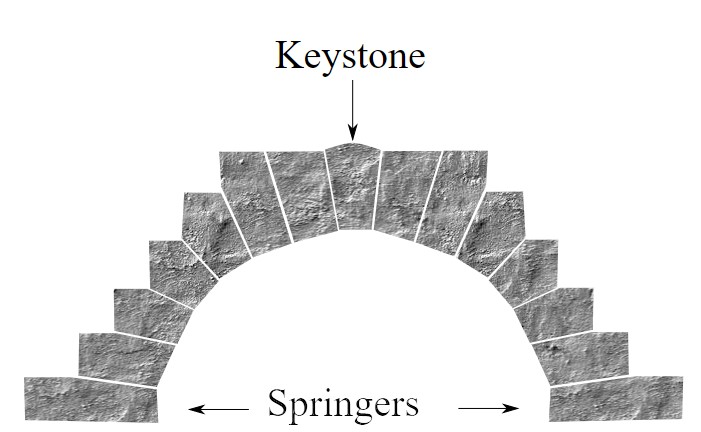Voussoir

|
| This image depicts the voussoir stones of an arch, including the keystone and the springers. |
Contents |
[edit] Introduction
The construction of traditional masonry arches and vaults is dependent on the arrangement of the bricks, blocks or stones over the opening. A tapered or wedge-shaped stone forming one of the units of the arch or vault is called a voussoir. Downward pressure on the structure has the effect of forcing the voussoirs together (in compression) instead of apart. Precision must be used when cutting voussoirs in order to ensure that this pressure is sufficient and uniform against the adjacent blocks.
Each unit in an arch or vault is a voussoir. The voussoir that is positioned in the centre of the arch is known as the keystone. The bottom voussoirs resting on the springing line are referred to as springers. The springing line is the point from which the arch starts to rise from its vertical supports.
[edit] Origins of the term
The term voussoir comes from the old French word vosoir, which has its origins in the Vulgar Latin word volvere (meaning to turn around or to roll). It is this reference, “to turn or roll”, that relates to the action of the wedge-shaped voussoir. Each voussoir rolls to the side to force it into place and create the supporting action needed to distribute weight.
[edit] History
Early voussoirs appeared in 16th century arches found in Italian Mannerist architecture. The technique created a stylistic departure from traditional Renaissance structures. They were also used with dramatic effect in other parts of the Mediterranean, sometimes created using red and white stones arranged in alternating patterns. This effect was also used in Romanesque architecture.
By the 18th and 19th century, bricks and mortar were used to create a new type of voussoir. British bricklayers found they could use standard bricks by thickening vertical mortar joints to produce an arch that was sufficiently supportive.
[edit] Related articles on Designing Buildings
Featured articles and news
CIOB report; a blueprint for SDGs and the built environment
Pairing the Sustainable Development Goals with projects.
Latest Build UK Building Safety Regime explainer published
Key elements in one short, now updated document.
UKGBC launch the UK Climate Resilience Roadmap
First guidance of its kind on direct climate impacts for the built environment and how it can adapt.
CLC Health, Safety and Wellbeing Strategy 2025
Launched by the Minister for Industry to look at fatalities on site, improving mental health and other issues.
One of the most impressive Victorian architects. Book review.
Common Assessment Standard now with building safety
New CAS update now includes mandatory building safety questions.
RTPI leader to become new CIOB Chief Executive Officer
Dr Victoria Hills MRTPI, FICE to take over after Caroline Gumble’s departure.
Social and affordable housing, a long term plan for delivery
The “Delivering a Decade of Renewal for Social and Affordable Housing” strategy sets out future path.
A change to adoptive architecture
Effects of global weather warming on architectural detailing, material choice and human interaction.
The proposed publicly owned and backed subsidiary of Homes England, to facilitate new homes.
How big is the problem and what can we do to mitigate the effects?
Overheating guidance and tools for building designers
A number of cool guides to help with the heat.
The UK's Modern Industrial Strategy: A 10 year plan
Previous consultation criticism, current key elements and general support with some persisting reservations.
Building Safety Regulator reforms
New roles, new staff and a new fast track service pave the way for a single construction regulator.
Architectural Technologist CPDs and Communications
CIAT CPD… and how you can do it!
Cooling centres and cool spaces
Managing extreme heat in cities by directing the public to places for heat stress relief and water sources.
Winter gardens: A brief history and warm variations
Extending the season with glass in different forms and terms.
Restoring Great Yarmouth's Winter Gardens
Transforming one of the least sustainable constructions imaginable.























